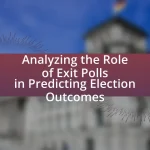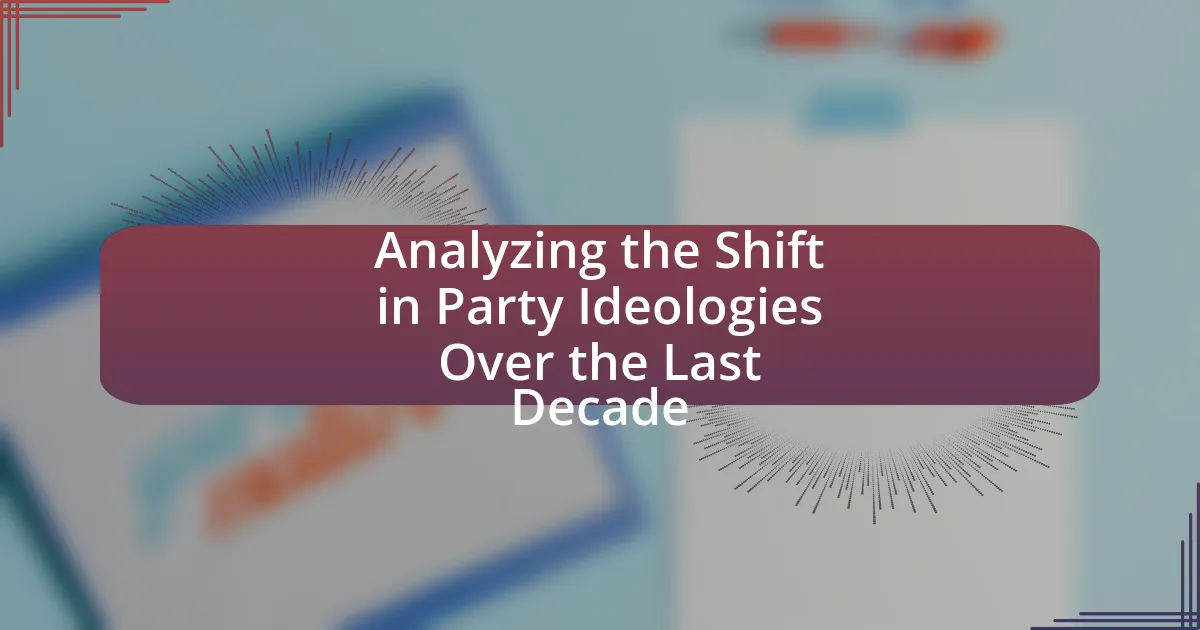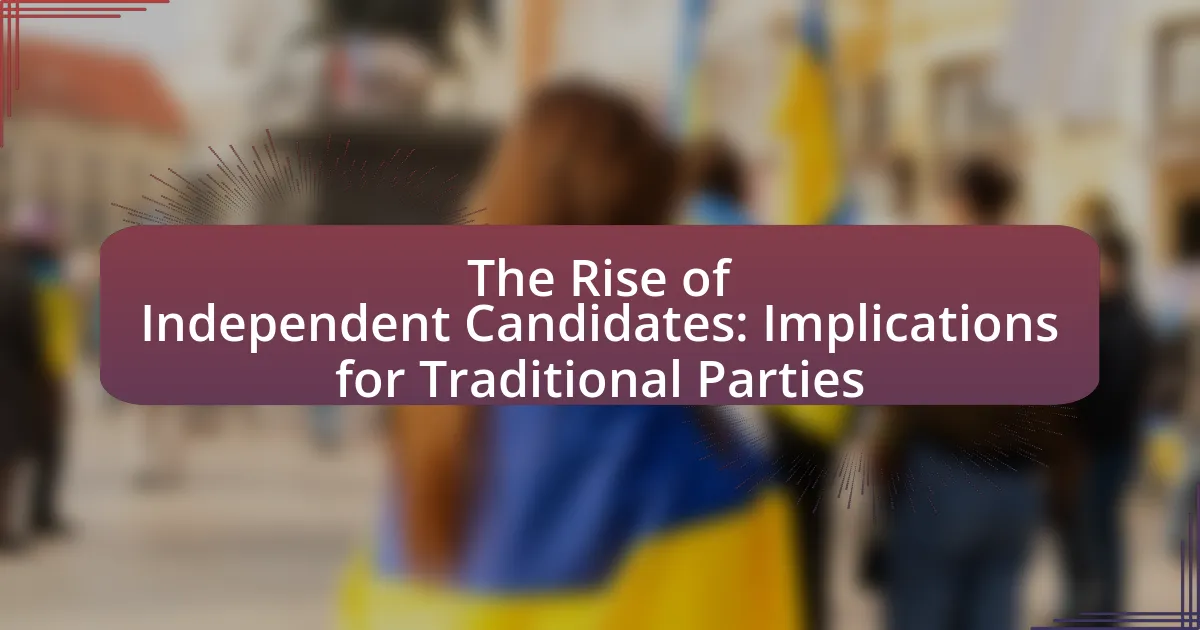The article examines the future of elections, focusing on key trends and predictions for the next decade. It highlights the increasing use of technology, such as electronic voting systems and online registration, which enhance security and accessibility. The rise of remote voting options and the impact of social media on voter engagement are also discussed, alongside demographic shifts that will influence electoral outcomes. Additionally, the article addresses challenges such as misinformation, voter suppression, and cybersecurity threats, while proposing best practices to maintain electoral integrity and enhance voter participation.
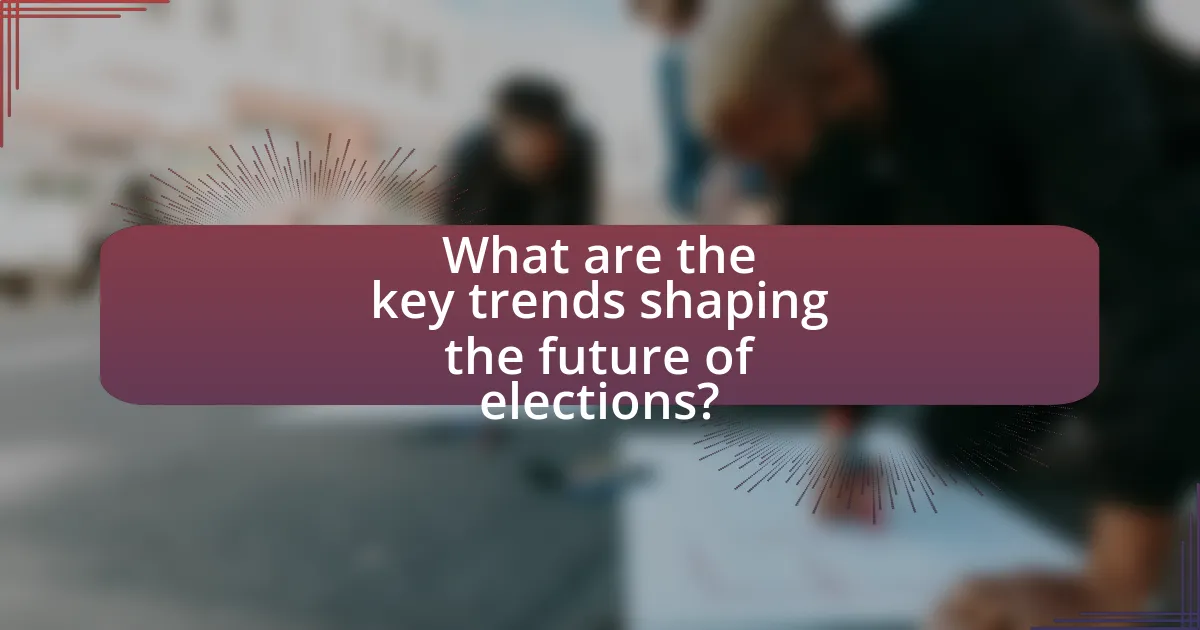
What are the key trends shaping the future of elections?
Key trends shaping the future of elections include the increasing use of technology, the rise of remote voting options, and the growing emphasis on voter engagement through social media. Technology, such as electronic voting machines and blockchain, enhances security and efficiency in the voting process. Remote voting options, including mail-in ballots and online voting, have gained traction, especially highlighted during the COVID-19 pandemic, which saw a significant increase in mail-in voting, with over 50% of voters in the 2020 U.S. election casting their ballots by mail. Additionally, social media platforms are becoming critical tools for political campaigns, allowing candidates to engage directly with voters and mobilize support, as evidenced by the fact that 69% of Americans reported using social media for political news in 2020. These trends indicate a shift towards more accessible, secure, and engaging electoral processes.
How is technology influencing electoral processes?
Technology is significantly influencing electoral processes by enhancing voter engagement, streamlining operations, and improving data analysis. Digital platforms enable candidates to reach a broader audience through social media and targeted advertising, which has been shown to increase voter turnout; for instance, a study by the Pew Research Center found that 69% of adults in the U.S. use social media, making it a vital tool for political communication. Additionally, electronic voting systems and online registration simplify the voting process, reducing administrative burdens and errors. The use of big data analytics allows campaigns to tailor their strategies based on voter behavior and preferences, leading to more effective outreach. Overall, technology is reshaping how elections are conducted and experienced, making them more accessible and data-driven.
What role do electronic voting systems play in modern elections?
Electronic voting systems play a crucial role in modern elections by enhancing efficiency, accuracy, and accessibility. These systems streamline the voting process, allowing for quicker vote casting and counting, which can lead to faster election results. For instance, according to the National Association of Secretaries of State, jurisdictions using electronic voting machines reported a reduction in the time taken to tally votes compared to traditional paper ballots. Additionally, electronic voting systems can improve voter accessibility, accommodating individuals with disabilities through features like audio ballots and touchscreens. This technological advancement is increasingly vital as more voters seek convenient and secure methods to participate in elections.
How are social media platforms impacting voter engagement?
Social media platforms significantly enhance voter engagement by facilitating direct communication between candidates and voters. These platforms allow for real-time interaction, enabling candidates to share their messages widely and engage with constituents on a personal level. According to a study by the Pew Research Center, 69% of adults in the U.S. use social media, which has become a primary source of political information for many voters. This increased accessibility to information and the ability to participate in discussions can lead to higher voter turnout, as evidenced by the 2018 midterm elections, where social media campaigns were linked to increased engagement among younger voters.
What demographic shifts are expected to affect future elections?
Demographic shifts expected to affect future elections include the increasing diversity of the electorate, particularly the growth of Hispanic and Asian populations, as well as the aging of the population. According to the U.S. Census Bureau, by 2045, it is projected that non-Hispanic whites will make up less than 50% of the U.S. population, leading to a more racially and ethnically diverse voter base. Additionally, the Pew Research Center indicates that younger voters, who tend to lean more progressive, are becoming a larger portion of the electorate as they age into voting age. These shifts are likely to influence policy priorities and electoral outcomes significantly.
How will changing population dynamics influence voter turnout?
Changing population dynamics will significantly influence voter turnout by altering the demographic composition of the electorate. As populations become more diverse, with increasing numbers of younger, urban, and minority voters, voter engagement strategies must adapt to address the unique needs and preferences of these groups. For instance, research from the U.S. Census Bureau indicates that younger voters, particularly those aged 18-29, have historically lower turnout rates compared to older demographics, but their increasing representation in the population could lead to higher overall turnout if mobilization efforts are effectively tailored to them. Additionally, studies show that urban areas, which tend to have higher concentrations of diverse populations, often experience different turnout patterns compared to rural areas, emphasizing the need for targeted outreach and education initiatives to enhance participation among these changing demographics.
What impact do generational differences have on voting behavior?
Generational differences significantly impact voting behavior, as distinct age groups exhibit varying political preferences and engagement levels. For instance, younger voters, particularly Millennials and Generation Z, tend to prioritize issues like climate change, social justice, and economic inequality, often favoring progressive candidates. In contrast, older generations, such as Baby Boomers and Generation X, may prioritize stability, economic growth, and traditional values, leading to different voting patterns. According to a Pew Research Center study, in the 2020 U.S. presidential election, 50% of voters aged 18-29 supported Joe Biden, while 47% of those aged 65 and older supported Donald Trump, illustrating the stark contrast in preferences across generations. This divergence in priorities and voting tendencies shapes electoral outcomes and influences campaign strategies, as candidates tailor their messages to resonate with specific age demographics.
What are the implications of global political changes on elections?
Global political changes significantly influence elections by altering voter behavior, party dynamics, and electoral policies. For instance, the rise of populism in various countries has led to increased polarization, impacting how parties campaign and engage with constituents. Additionally, shifts in international relations, such as trade agreements or conflicts, can sway public opinion and voter priorities, as seen in the 2016 U.S. presidential election where global trade issues played a crucial role. Furthermore, changes in governance, such as the adoption of new technologies for voting or the implementation of stricter voter ID laws, can directly affect voter turnout and election outcomes. These implications underscore the interconnectedness of global political trends and their direct effects on the electoral landscape.
How do international relations affect domestic electoral outcomes?
International relations significantly influence domestic electoral outcomes by shaping public opinion and political agendas. For instance, events such as military conflicts, trade agreements, or diplomatic crises can sway voter sentiment, often leading to shifts in support for political parties or candidates. A notable example is the impact of the 2003 Iraq War on the U.S. elections; public discontent over the war contributed to the Democratic Party gaining control of Congress in the 2006 midterm elections. Additionally, international economic conditions, such as recessions or booms, can affect domestic policies and voter priorities, further influencing electoral results.
What lessons can be learned from recent elections worldwide?
Recent elections worldwide highlight the importance of voter engagement and the impact of technology on electoral processes. High voter turnout in countries like Australia, where participation rates exceed 90%, demonstrates that accessible voting methods and civic education can significantly enhance public involvement. Additionally, the use of digital platforms for campaigning and voting, as seen in Estonia’s e-voting system, shows that technology can streamline the electoral process and increase transparency. These examples underscore the necessity for electoral reforms that prioritize accessibility and innovation to foster democratic participation in the future.
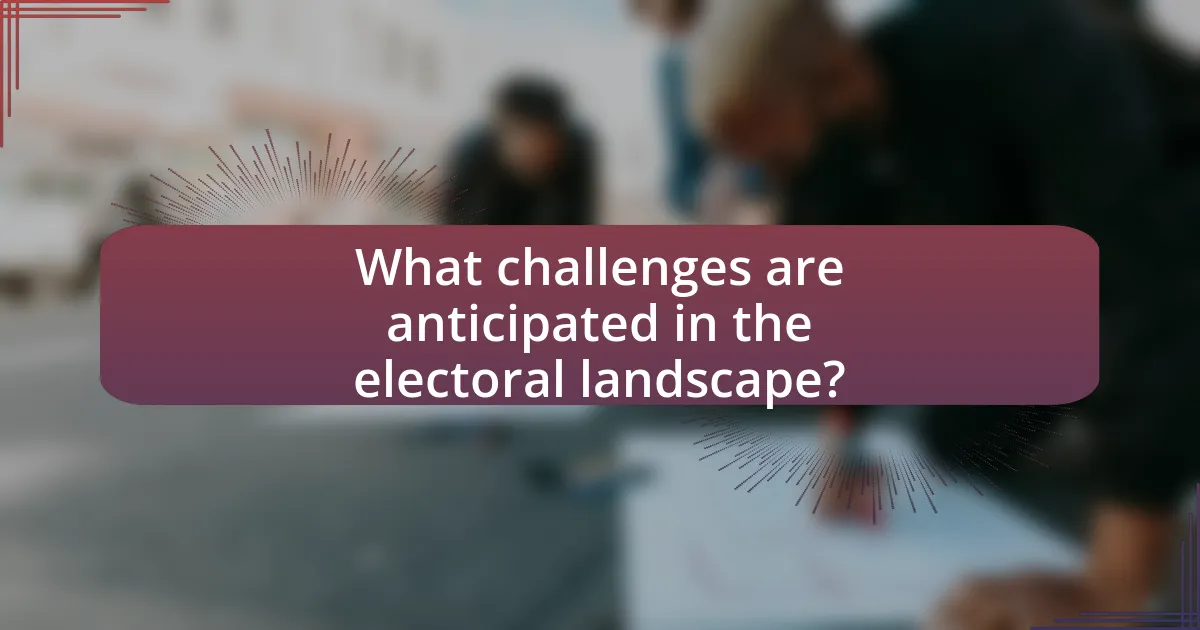
What challenges are anticipated in the electoral landscape?
Challenges anticipated in the electoral landscape include voter suppression, misinformation, and cybersecurity threats. Voter suppression tactics, such as strict ID laws and purging voter rolls, can disproportionately affect marginalized communities, leading to decreased participation. Misinformation campaigns, particularly on social media, can distort public perception and influence voter behavior, as evidenced by the significant impact of false information during recent elections. Additionally, cybersecurity threats pose risks to the integrity of electoral systems, with increasing incidents of hacking and data breaches reported in various countries. These challenges necessitate robust measures to ensure fair and secure elections in the future.
How will misinformation and disinformation affect elections?
Misinformation and disinformation will significantly undermine the integrity of elections by distorting public perception and influencing voter behavior. Studies indicate that false information can sway electoral outcomes; for instance, a 2017 study published in the journal “Nature” found that misinformation on social media can lead to a 20% increase in the likelihood of individuals changing their voting preferences. Furthermore, disinformation campaigns can create polarization among voters, eroding trust in electoral processes and institutions. The 2016 U.S. presidential election serves as a prominent example, where targeted disinformation efforts were linked to shifts in voter sentiment and turnout.
What strategies can be implemented to combat electoral misinformation?
To combat electoral misinformation, strategies such as enhancing media literacy, implementing fact-checking initiatives, and promoting transparency in information sources can be effectively utilized. Enhancing media literacy equips voters with the skills to critically evaluate information, reducing susceptibility to false claims. For instance, educational programs that teach individuals how to identify credible sources and discern factual information from misinformation have been shown to improve public understanding of electoral processes. Fact-checking initiatives, such as those conducted by organizations like PolitiFact and FactCheck.org, provide timely verification of claims made during campaigns, helping to clarify misinformation before it spreads. Additionally, promoting transparency in information sources, including requiring social media platforms to disclose the origins of political advertisements, can help voters make informed decisions based on reliable information. These strategies collectively contribute to a more informed electorate and a healthier democratic process.
How does misinformation influence voter perceptions and decisions?
Misinformation significantly influences voter perceptions and decisions by shaping beliefs and attitudes towards candidates and policies. Studies indicate that exposure to false information can lead to misinformed voters who may support candidates based on inaccurate narratives. For instance, research published in the journal “Political Communication” found that misinformation can create cognitive biases, leading voters to reinforce their pre-existing beliefs rather than critically evaluate information. Furthermore, a survey by the Pew Research Center revealed that 64% of Americans believe fabricated news stories cause confusion about basic facts, which can directly impact electoral outcomes by swaying undecided voters or solidifying partisan divides.
What security concerns are associated with future elections?
Future elections face significant security concerns, primarily including cyber threats, misinformation campaigns, and vulnerabilities in voting infrastructure. Cyber threats, such as hacking attempts on election systems, have been evidenced by incidents like the 2016 U.S. presidential election, where Russian operatives targeted state election systems. Misinformation campaigns, often spread through social media, can undermine public trust and manipulate voter perceptions, as seen in various global elections. Additionally, outdated voting machines and lack of proper security protocols expose vulnerabilities that can be exploited, as highlighted by the U.S. Cybersecurity and Infrastructure Security Agency’s warnings about election security. These factors collectively pose serious risks to the integrity and reliability of future electoral processes.
How can election systems be protected from cyber threats?
Election systems can be protected from cyber threats by implementing robust cybersecurity measures, including multi-factor authentication, regular software updates, and comprehensive training for election officials. Multi-factor authentication enhances security by requiring multiple forms of verification, making unauthorized access more difficult. Regular software updates address vulnerabilities that could be exploited by cyber attackers, as evidenced by the 2020 U.S. elections where outdated systems were targeted. Comprehensive training for election officials ensures they are aware of potential threats and can respond effectively, as highlighted by the Cybersecurity and Infrastructure Security Agency’s guidelines which emphasize the importance of preparedness in safeguarding electoral integrity.
What measures are necessary to ensure voter data privacy?
To ensure voter data privacy, implementing robust encryption methods for data storage and transmission is essential. Encryption protects sensitive voter information from unauthorized access and breaches, as evidenced by the National Institute of Standards and Technology (NIST) guidelines, which recommend using advanced encryption standards (AES) for securing personal data. Additionally, establishing strict access controls and authentication protocols limits data access to authorized personnel only, further safeguarding voter information. Regular audits and compliance checks with privacy regulations, such as the General Data Protection Regulation (GDPR), also play a critical role in maintaining voter data privacy by ensuring adherence to established data protection standards.
What legal and regulatory changes are expected in electoral processes?
Legal and regulatory changes expected in electoral processes include the implementation of stricter voter ID laws, increased use of technology for voting, and enhanced measures for cybersecurity. Stricter voter ID laws aim to reduce voter fraud, as seen in states like Georgia and Indiana, which have enacted laws requiring specific forms of identification. The increased use of technology, such as electronic voting machines and online voter registration, is anticipated to streamline the voting process and improve accessibility. Additionally, heightened cybersecurity measures are being prioritized to protect electoral integrity, especially following concerns raised by incidents of foreign interference in the 2016 and 2020 U.S. elections. These changes reflect a broader trend towards modernization and security in electoral systems.
How might campaign finance laws evolve in the next decade?
Campaign finance laws are likely to evolve towards increased transparency and regulation of digital advertising in the next decade. As political campaigns increasingly rely on social media and online platforms for fundraising and outreach, lawmakers may implement stricter disclosure requirements for online donations and expenditures. For instance, the Federal Election Commission has already begun discussions on how to address the challenges posed by digital platforms, indicating a trend towards more comprehensive regulations. Additionally, public sentiment is shifting towards limiting the influence of dark money in politics, which could lead to reforms aimed at reducing anonymous contributions and enhancing accountability.
What role will voter ID laws play in shaping future elections?
Voter ID laws will significantly influence future elections by potentially increasing voter turnout among those who possess the required identification while simultaneously posing barriers for those who do not. Research indicates that states with strict voter ID laws often see a decrease in participation, particularly among minority and low-income populations. For instance, a study by the National Bureau of Economic Research found that voter ID laws can reduce turnout by as much as 2-3 percentage points in certain demographics. This dual effect of facilitating some voters while disenfranchising others will shape electoral outcomes and the overall democratic process in the coming decade.
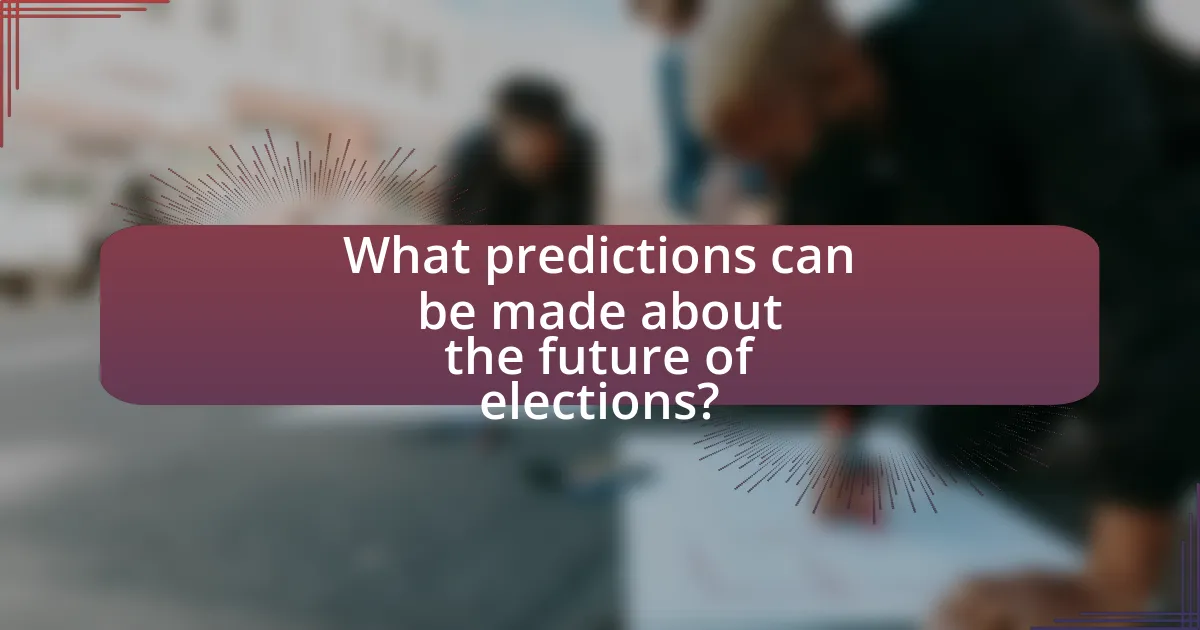
What predictions can be made about the future of elections?
Predictions about the future of elections indicate a significant increase in the use of technology, particularly digital voting systems and online voter registration. Research from the Pew Research Center shows that as of 2021, 60% of Americans support online voting, suggesting a trend towards more accessible and efficient voting methods. Additionally, the rise of artificial intelligence in analyzing voter behavior and preferences is expected to shape campaign strategies, as evidenced by the 2020 U.S. elections where data analytics played a crucial role in targeting voters. Furthermore, concerns over election security and misinformation are likely to lead to stricter regulations and enhanced cybersecurity measures, reflecting the ongoing challenges faced in maintaining electoral integrity.
How will voter participation evolve in the next decade?
Voter participation is expected to increase in the next decade, driven by factors such as technological advancements, demographic shifts, and heightened civic engagement. Research indicates that younger generations, particularly Millennials and Gen Z, are becoming more politically active, with a 2020 study by the U.S. Census Bureau showing a significant increase in turnout among these age groups compared to previous elections. Additionally, the implementation of online voting and improved access to information is likely to facilitate greater participation. Historical trends suggest that as barriers to voting are reduced, such as through automatic voter registration and expanded mail-in voting options, overall voter turnout tends to rise.
What innovations could enhance voter turnout and engagement?
Innovations such as online voter registration, mobile voting applications, and enhanced use of social media can significantly enhance voter turnout and engagement. Online voter registration simplifies the process, making it more accessible; for instance, states that implemented online registration saw increases in voter registration rates by up to 20%. Mobile voting applications provide convenience, allowing voters to cast their ballots from anywhere, which can lead to higher participation rates, as evidenced by pilot programs in various jurisdictions showing increased turnout. Additionally, leveraging social media platforms for voter education and outreach can engage younger demographics, with studies indicating that social media campaigns can increase awareness and participation among users by as much as 30%.
How might the concept of voting change with new technologies?
The concept of voting may change significantly with new technologies by enabling more accessible, secure, and efficient voting processes. Innovations such as online voting platforms, blockchain for secure ballot tracking, and biometric identification can streamline voter participation and enhance election integrity. For instance, a study by the National Institute of Standards and Technology found that electronic voting systems can reduce human error and increase voter turnout by making the process more convenient. Additionally, the use of artificial intelligence can help in analyzing voter data to improve outreach and engagement strategies, further transforming the electoral landscape.
What future electoral models are being proposed?
Future electoral models being proposed include ranked-choice voting, proportional representation, and online voting systems. Ranked-choice voting allows voters to rank candidates in order of preference, which can lead to more representative outcomes and reduce the impact of vote-splitting. Proportional representation aims to allocate seats in the legislature based on the percentage of votes each party receives, promoting a multi-party system and enhancing voter choice. Online voting systems are being explored to increase accessibility and participation, particularly among younger voters, although concerns about security and integrity remain. These models are being discussed in various electoral reform initiatives and studies, reflecting a shift towards more inclusive and representative democratic processes.
How could ranked-choice voting reshape electoral outcomes?
Ranked-choice voting (RCV) could reshape electoral outcomes by allowing voters to rank candidates in order of preference, which can lead to more representative results and reduce the impact of vote-splitting. This voting method encourages candidates to appeal to a broader electorate, as they seek second and third-choice votes, potentially increasing voter engagement and satisfaction. For example, in the 2020 Maine congressional election, RCV resulted in a candidate winning with a majority of votes after multiple rounds of counting, demonstrating its ability to reflect the electorate’s true preferences more accurately than traditional plurality voting.
What are the potential benefits of online voting systems?
Online voting systems offer increased accessibility, convenience, and efficiency in the electoral process. These systems enable voters to cast their ballots from any location with internet access, thereby reducing barriers such as transportation issues and long wait times at polling places. A study by the National Institute of Standards and Technology found that online voting can lead to higher voter turnout, particularly among younger demographics and those with disabilities, as it simplifies the voting process. Additionally, online voting can streamline the counting process, reducing the time required to tally votes and announce results, which enhances the overall efficiency of elections.
What best practices can be adopted for future elections?
To enhance future elections, adopting best practices such as implementing secure and accessible voting technology, ensuring transparency in the electoral process, and promoting voter education is essential. Secure voting technology, like paper ballots combined with electronic systems, has been shown to reduce fraud and increase voter confidence, as evidenced by studies from the National Institute of Standards and Technology. Transparency can be achieved through independent audits and open access to election data, which fosters trust among the electorate. Additionally, comprehensive voter education campaigns can increase participation rates, as demonstrated by the increase in voter turnout in states that have invested in such initiatives.
How can electoral integrity be maintained in a changing landscape?
Electoral integrity can be maintained in a changing landscape through the implementation of robust cybersecurity measures, transparent voting processes, and continuous voter education. Cybersecurity measures are essential as they protect electoral systems from hacking and misinformation, which have been increasingly prevalent; for instance, the 2016 U.S. elections highlighted vulnerabilities in electoral infrastructure. Transparent voting processes, such as using paper ballots alongside electronic systems, enhance trust and allow for audits, as demonstrated by countries like Germany, which mandates paper trails for electronic voting. Continuous voter education ensures that citizens are informed about their rights and the electoral process, reducing the likelihood of manipulation and fostering participation, as evidenced by initiatives in countries like Australia that have successfully increased voter turnout through education campaigns.
What role do civic education and outreach play in future elections?
Civic education and outreach play a crucial role in future elections by enhancing voter awareness and participation. Effective civic education equips citizens with knowledge about their rights, the electoral process, and the importance of their vote, which can lead to increased voter turnout. For instance, studies show that informed voters are more likely to engage in elections; the U.S. Census Bureau reported that in the 2020 election, states with robust civic education programs saw higher participation rates. Outreach initiatives, such as community workshops and informational campaigns, further bridge gaps in understanding, particularly among underrepresented groups, ensuring that diverse voices are heard in the democratic process.

